Do you have a local business, or maybe clients that own local businesses? If yes, then you’re in the right place, because you’re going to find out how you can double or even triple their click-through rates on Google.
People often think that they can only rank once for a keyword. For the most part that’s true, because Google has gradually restricted the number of times you can show up with the same domain on the same search query. However, things are a little bit different when it comes to some businesses.

About Multiple Listings on Google
- Advertise with Google Adwords
- Google My Business (Google Maps)
- SEO & Organic Search Results
- Facebook Pages & Social Profiles
- Google Answer Boxes
- Which Method Should You Focus on First?
- Ranking Multiple Pages From Your Website. Is it even possible?
Before we get into the specifics, let’s see why it’s hard to get multiple listings on Google in general and why local businesses have an advantage.
About Multiple Listings on Google
Multiple listings have been a concern for Google for a pretty long time. Plenty of changes have been made over time, but things have finally started to settle.
Although you can see multiple listings from the same domain on organic results, that happens rather rarely. Google’s algorithms are set up to increase the difficulty of ranking again, proportionally to the number of times a domain is already ranking.
Matt Cutts explains the phenomenon pretty well in the following video.
This video is yet another reason why blackhat SEOs make everyone else’s life harder. Google had to constantly change to adapt to people trying to manipulate the system.
If you try to rank multiple pages on the same keywords, some of your pages might end up in Google’s omitted results. Even worse, if you have a lot of pages competing for the same keyword, you might get into keyword cannibalization.
When Google has too many options to choose from, it gets annoyed. You risk getting a small penalty for that, which will result in lower overall rankings for that keyword.
Now you can always try to create multiple listings and manipulate the organic searches by buying more domains and pretending you’re not the same person, but it’s a risky move. If Google flags your network as a Private Blog Network, it will compromise all your websites. Since the laws of certain countries require visible business info on websites, a link between your sites can’t be easily avoided.
However, things are very different for local SEO. Why? Because there are multiple listings. First, we have Google Adwords, then we have the local business listings from Google Maps and lastly, we have the organic results. If you can get to the top of all three, you’re in for a guaranteed triple CTR to your business.
Solution #1. Advertise with Google Adwords
We’re going to cover this first, because it’s the highest listing you can get (above MyBusiness Listings and Organic search results). However, that’s not always true, considering ads can sometimes be displayed on the right sidebar, at the bottom of pages and even on second or third pages, depending on quality.
Although you can use Adwords to get multiple listings on any keywords, it’s known that Google will sometimes decide not to show any ads, if no relevant ads are found. For local businesses, on the other hand, chances of ads showing are pretty high.
The advantage of using Google Adwords is that you’ll get results as soon as you set up your first campaign. The downside, obviously, is that you have to pay.
Depending on the competitivity of your niche and also your skills on managing paid advertising campaigns, the costs can vary.
Furthermore, you can also take into account that the CTR for Adwords is only 2% of the total number of clicks on Google. The rest goes to organic searches. However, for local businesses people might be clicking more on maps and MyBusiness listings than on organic results.
Warning: Google Adwords and PPC in general is pretty difficult. Your budget can burn out really quickly if you don’t know what you’re doing! This post doesn’t cover everything about PPC. It’s always a good idea to let an expert handle your campaigns, but if you’re interested in learning more, you should can out this awesome PPC guide.
1. Set Up Your Account
This is fairly simple and straight-forward. You need to go to Adwords’ Homepage and set up an account. If you don’t have a Google account, you’ll have to create one.

If you already have a Google/Gmail account, the setup will be a lot easier. Just log into your account on Chrome or any other browser, go to https://adwords.google.com and click on Start Now.

The steps are pretty easy to follow. I’m sure you’ll be able to get past the account setup. What’s really cool about Adwords compared to SEO is that you get live phone support from Google itself. I recommend that you use it to your advantage, especially if it’s for setting up your first campaign.
2. Choose or Create Your Landing Page
Your landing page is very important for the success of your campaign.
First of all, you need to have a landing page that satisfies Google. It makes a lot of sense that Google also analyses the quality of the landing page you’re going to show for your ad, because otherwise, the highest bidder would always win, leaving no room for fair play or quality.
Google doesn’t only look at the money. If it was so, nobody would use Google by now. I mean, look at Yahoo! Don’t you just hate it when the entire background is an ad? I know I do!
Secondly, you need to A/B test during your campaign to optimize for better opt in rates. If your goal is for clients to fill up a form, then you have to constantly test out what makes more people do it.

Now I’m no Adwords expert, but friends of mine that are have told me that SEO criteria match the quality signals for Adwords landing pages, so keep this in mind when you’re building them.
However, it’s a bad idea to use the same pages that you use for organic traffic on your Adwords Campaigns. Search Engine Optimized pages are usually filled up with more content. Since you’re main purpose here is to get leads or make sales, adding more content might have an impact on the page’s performance.
For maximum profit and efficiency, make sure you use landing pages specifically designed for your ads and for your goals.
3. Create a Campaign
Once you finish creating your account, Google will ask you for your website. Provide it to enter the Adwords Dashboard. From there, find the Create New Campaign button. It sometimes also looks like a + sign.

There are multiple types of campaigns that you can set up, but we’re interested in the Search Network and or Display Network.
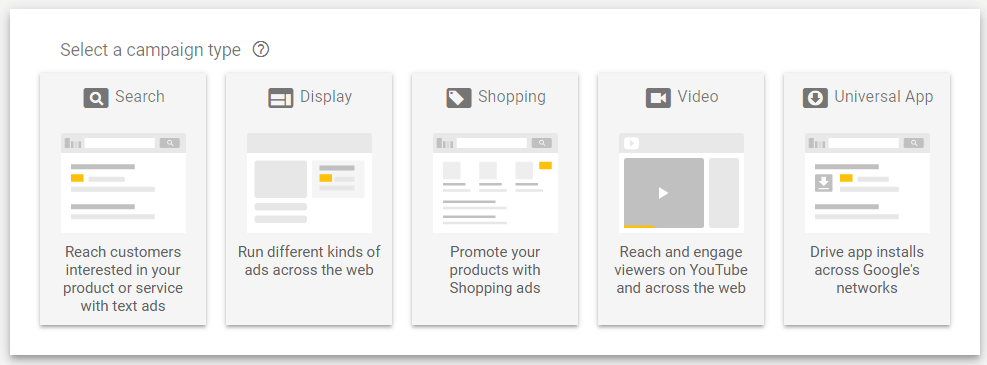
Search Network means that your ads will show up when people search for particular keywords that you pick. Display Network means that your ads will also show up on other people’s websites, if they’re using Adsense. This type of advertising is called retargeting, as it can follow users for a long time after they perform a search and show them your ads. It’s also more visual, as you can display image ads, animated gifs and even videos.
You can pick any one of them or both, but keep in mind that the latter is more expensive.
4. Set Up Your Budget, Target Audience and Keywords
All these details are very important and you’ll learn more about them only through practice and experience. Start with a small budget at first, to test things out. You can always expand.
You can also use Google’s Keyword Planner to do keyword and bidding research. That way, you will be able to find out what people are searching for, how much your competition pays on average and also if the competition is low or high.

How to get to the Keyword Planner Tool
You can use these criteria to determine a budget and an average bid for your ad. After you do your keyword research, set up your target audience and write a list of keywords you want to target. Don’t add all the keywords you can find. Only add very similar and close ones. Create more ad groups to be able to add the keywords in the title, description and URL of your ad when creating it. This will help with your click through rates.
Usually, the calculations are pretty simple. If your service/product is worth $100 and the cost per click is 1$, you’ll have to make 1 sale every 100 clicks just to break even. However, Google can’t tell you how many clicks you’re going to get. This is up to you and how your ad and landing page are written.
5. Write Your Ad
Finally, we got here! Things on this step aren’t too dificult. Just create your heading, description and URL. The URL is fake but, as I previously mentioned, having the keywords that the user has just searched helps a lot. When the users click, it will redirect them to your landing page.
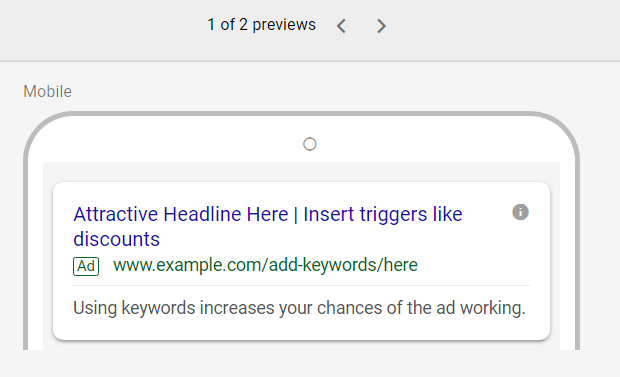
After you finish writing your ad, you will have to reach for your wallet and pull out your credit card. Google won’t allow you to publish the ads without a credit card linked to your business account.
However, it won’t start charging you instantly. Google doesn’t pull money from your card on every click. Instead, it adds them up till a certain point and then withdraws a bigger amount from time to time.
6. Extra PPC tips
PPC isn’t easy to get right. You can burn out through your budget really quick if you don’t know what you’re doing. In order to help you not lose money, here are some useful tips:
Using exact match at first: There are 3 types of keywords you can use in your Adwords PPC campaign: broad, phrase match and exact match. Broad means that the add will appear on any queries containing that word.
For example, if I run a campaign on the word “seo” on broad match, the ad will obviously show for the query “seo”, but it can also show for “white hat seo” or “black hat seo” because they also contain “seo”.
You might want to start off by using only exact match type keywords. Why? Because this way you’ll know exactly what you’re paying for. Be specific with your keywords!
Using exact match at first is an easy way to view your campaign running, because you’ll know exactly on which queries your ad should show up.
Add your negative keywords: If you’re going to set up your campaigns and ads running on broad match types, then you have to make sure you add negative keywords. Forgetting or not knowing about them is one of PPC newbies’ biggest mistakes.
Well. they are kind of right, as negative keywords deny the possibility of an ad to show up. For example, if I run a campaign for the word “seo” in broad match but then add “black” as a negative keyword, then the ad will show up for “white hat seo” but will not show up for “black hat seo”.
The thing with negative keywords is that you only can think of some of them. They can be thousands! To find them, you’ll have to keep optimizing your campaign as you go. This also means paying some money. When a user will search for a keyword which you don’t want to pay for and click on your result, you’ll pay once to know that keyword and add it to the negative keywords list.
Have a CTA on your page: Don’t waste your money! Every page should have a CTA (call to action), especially if it’s one that’s running on a pay per click campaign. In fact, you should have a CTA on any page, ever. If visitors land on it, you want to tell them what they can do (buy, subscribe, visit another page etc.).
Solution #2. Set Up Your Google My Business Listing (Google Maps)
If you don’t have a Google MyBusiness listing yet, then you should make one right now, as you read this article. It’s easy and, most importantly, it’s completely free Google advertising. Don’t expect to get crazy traffic, as you’ll only be ranking depending primarily on the user’s location, but if you know what you’re doing it can work really well!
1. Set Up Your Account
For this, you need to follow the same steps as for creating the Adwords account. The steps are very similar.

However, there’s a chance that your business is already listed. I really don’t know how Google does it, as often times every detail is right on the spot, from phone number to working hours. I assume they have some sort of field agents, or secret shoppers. Who knows?
If your business is already listed, you can claim the ownership pretty easy:

2. Fill in All the Details Correctly
Google will ask your for a lot of details about your business. Make sure you answer them all correctly.
Don’t rush to pick the category. Choose the right one, as Google will also try to rank your page for queries that it thinks are related to the category. Add some keywords to your description, as well as a CTA. Don’t just stuff them in, though. Try to make it readable.
Next you’ll have to fill in the address, phone number and working hours. Try to keep them the same across the web. If you have another address on Facebook and your website, Google might notice that and think it’s inconsistent.
Fill everything up. The more info you give, the better it will help you rank.
3. Get Some Fancy Pictures
Pictures are very important for the local listing. Why? Because people are very interested in seeing them. For example, if you’re a restaurant, they might want to take a look at the surroundings and dishes. If you produce construction materials, they might want to see some screenshots of your products.
However, what’s most important for the start are pictures with the location itself, especially the entrance. If it’s a local business, it means that people want to go there physically. Help them find your place. Sometimes, trees are blocking Google Street View, and if your hair saloon is on the second floor of a building, people might be confused.

You can even include pictures with your staff. That’s always cute. Your clients can also post pictures at your location, so make sure you always treat them right. You don’t want pictures with bugs in your dishes getting on the Google Maps listing. If there is one downside to it, it’s that it’s very, and I need to emphasise on this, VERY HARD to remove a Local Business listing.
4. Get Some Reviews
Reviews are a very important ranking factor when it comes to local map listings. However, it’s a double sided blade. If you get negative reviews, it won’t help too much.
Remember, people are more inclined to leave a negative review than they are to leave a positive one. You’ll need action for a positive review, so make sure you have some sort of gamified system in place to convince your clients to leave one.

If you do get negative reviews, make sure you address them with a positive attitude. Apologize if it was your mistake and never insult or get angry if it’s just a dumbass (see what I did there?). Also, never try to rub your own back here. Google can figure out fake reviews if they’re coming from the same devices/IPs/locations.
Although location and reviews are probably the most important ranking factors for maps listings, there are other ranking factors that you can take into account. I wrote an article on this. You can read it here.
If you want to have Google business listings in multiple locations, then you just repeat these steps. Don’t try to trick Google! The rule is one listing per location, so if you don’t have two shops, don’t create two listings.
5. Get Mentions / Citations
Google likes to see it when your business’ name is mentioned on the internet. If possible make it so that it’s mentioned a lot in local news sites or other websites related to your location.
The more your name is mentioned around the address you’re trying to rank for, the more Google will associate your business listing with that location and boost it in the search rankings.
Solution #3. Get Your Website Ranking High in the Organic Search Results
This is by far the most complex thing in this list. Counterintuitively, it’s also going to be the shortest section. You’ll have to read far more from our blog to get a better understanding of SEO, but we will at least cover the basics.
You might not even need a website for your local business. However, you’ll never be able to get multiple listings without one, as it’s mandatory for both paid search and organic results. If you don’t want to spend money now on building one, Google MyBusiness offers a free one. It’s very limited and doesn’t come up with a top level domain, but hey, it’s a website!
In order to get your website ranking naturally in Google, without the use of ads, you have to take good care of it, write useful content and promote it properly.
1. Fix Technical Issues
The first thing you want to do is make sure your website runs smoothly. Technical issues include but aren’t limited to optimizing images, minifying HTML, CSS and JS and leveraging browser cache.
You’re looking for a page load time of maximum 3 seconds. It’s known that conversions drop if your website loads slowly, so you can make this a priority. It will affect you greatly long term. If after all the optimizations the website is still running very slow, consider contacting your web hosting provider and ask them to increase resources, or even switch hosts.
If you run your website on a CMS (Content Management System) like WordPress, then things are pretty easy, because you can use plugins. Just search “issue you want to fix” + WordPress plugin on Google and you’ll get what you need. There are plugins out there for virtually anything you want to do. Make sure you pick a plugin that has been recently updated and has a lot of positive reviews.
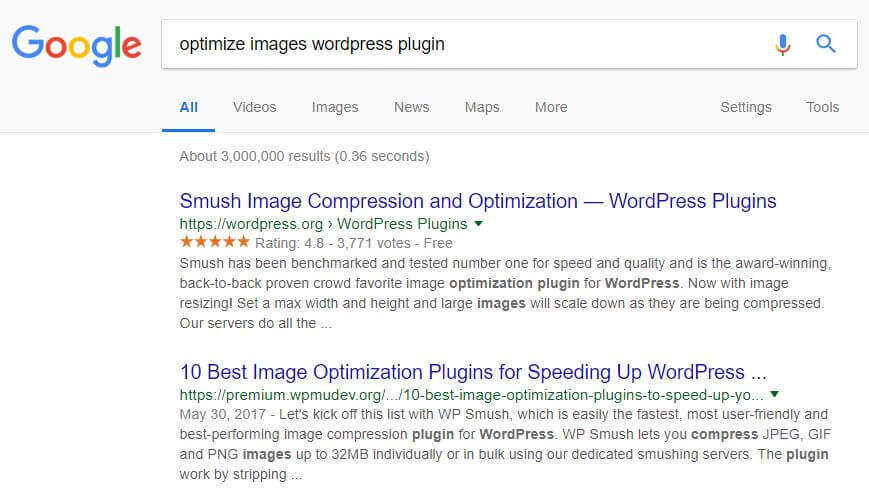
Example showing how to find WordPress plugins
You can do the same thing for other platforms, such as Joomla, Drupal or Magento. Although most of them are free, some more advanced plugins may require payment.
For a full list of what you need to do, you can check out our awesome article about fixing technical issues on your website.
2. Keywords, Content and UX (OnPage SEO)
The technical stuff is also OnPage SEO, but here we’re only going to talk about the content. Google ranks your pages depending on the quality of the content. It’s really hard to say what good content means, but a fair thing to say is that the user’s experience matters a lot.
Google has been looking into things like keyword density for a long time but, more recently, it has started analyzing things that include how much time a user spends on a page or if they hit the back button to search for something else. Google’s algorithms will record a user’s experience and rank your web pages according to it.
However, before you consider A/B testing and optimizing your page for a better user experience, make sure you have the proper keywords in your Title Tag and Headings. Even in 2018+ it’s pretty obvious that without them, you won’t be able to rank. You can use the same keywords from Adwords.
Did You Know
If you want your content to be very well optimized, you can use the Content Assistant. Even if you’re an experienced content writer or your a beginner in the field, this content optimization tool will help you out. You will get to write pieces of content for humans, not for robots but fully optimized for the search engines.
You’ll get the exact keywords you should use in order to have an SEO-friendly piece of content. You’ll also get to see what did your competitors use in terms of content and links to rank high in Google.
3. Promotion (OffPage SEO)
You can always kickstart a new piece of content with ads. However, it’s a better idea to use social media instead of adwords for this one. Before you do that, though, try to promote it for free in local groups, or groups related to your industry.
Speaking of social media, if you don’t have a Facebook page for your business yet, make sure you get one. In fact, go ahead and secure as many social profiles as you can. Some will fit your business and others won’t. For example, Pinterest works very well for restaurants, while Twitter works very well in the business and IT niches.
Your main purpose here is to get other websites to link to your site. You can also steal your competitor’s links by using the CognitiveSEO Toolset, or get notified when someone mentiones you or your competitors online by using BrandMentions. After you get notified, you can establish a relationship with whoever mentioned you, for further promotion.
For local SEO, it’s a great idea if you get links from other local websites. You can go ahead and create some links yourself, but if you scale this up, you can get in trouble with the big G. However, creating a few listings on local websites shouldn’t do any harm.
Also, don’t forget to promote offline. Online works best with offline. You can barter with other adjacent businesses around you that aren’t direct competitors. You’ll both have something to win this way and it will cost you nothing.
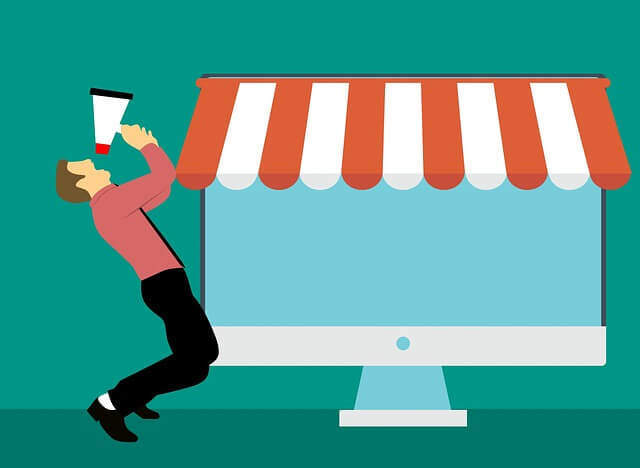
If you keep doing this, you should start seeing results over time. You can use our Rank Tracker to monitor your progress.
Solution #4. Facebook Page & Social Profiles
While not very common in highly competitive niches, in local ones it’s fairly easy to rank a Facebook Page to the top of Google. While on Facebook Pages you don’t have total control over the content, users are generally very familiar with the platform and will easily spot important contact details.
Sometimes, you can also get YouTube channels or videos to rank and even LinkedIn profiles, but we’ll talk mainly about Facebook for now.
1. Secure Your Profile
The first step is to secure your profile. Make sure you have a Facebook Page created with your brand name in it. Try to also secure your URL to make it easier to share with your audience.
2. Use Keywords in the Title & Description
The second step is optimizing that page for search. First you nave to make sure you add some important keywords in your Title and Description. One example could be “CognitiveSEO – SEO Tools”.
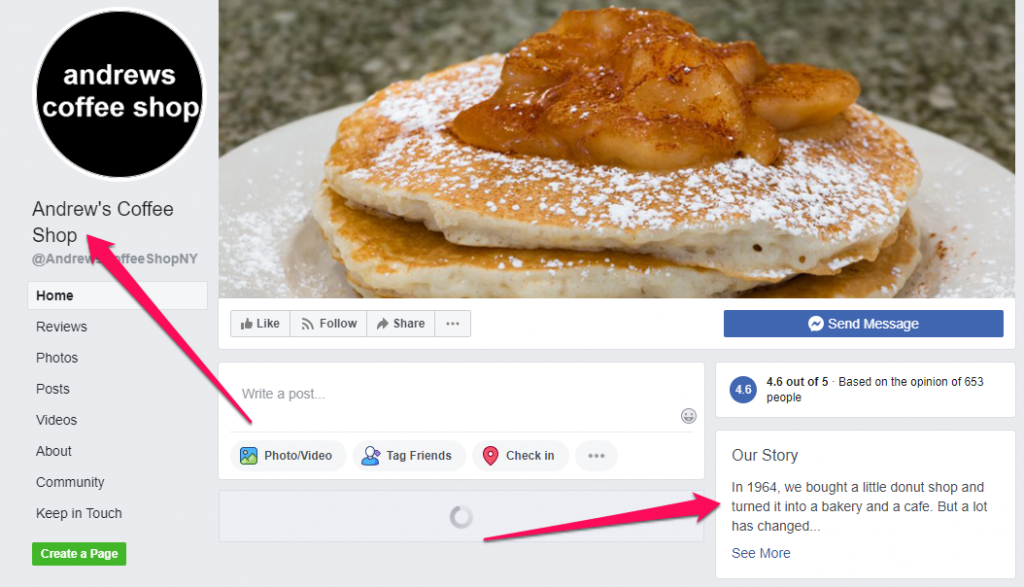
They make sure to fill your About section with some relevant, keyword right content. This is important, as Google will take a look at that content to figure if the page is relevant for some queries.
Don’t forget to link to your website! Then you can focus on other things such as design, call to action buttons and chatbot marketing.
3. Keep it active!
Social isn’t meant to rank, but to connect. If you have a social profile, then you MUST engage with your audience.
Post interesting stuff regularly, interact with your users, get them to like, comment on and share your posts. You’ll need to be creative. You can make promotional posts, but don’t abuse it! If you only do promotional posts, your reach might decline.

You can also try to build some links to the Facebook page. Start by adding it on your website. The easiest way to get some links is to get shares from other local Facebook pages.
A cross-promo strategy might work well here. As a quick tip: you don’t have to cross-promo with your competition. You can find adjacent niches in your area. For example, people often drink coffee while reading the newspaper, so a cross promo with the magazine store next street might work (if they also have a Facebook page and don’t sell coffee).
Why shares from pages and not profiles? Because profiles are often not public and therefore the content on them isn’t indexed by Google. Getting a share from a page that’s also indexed in Google means that Google will be able to see that backlink pointing back to your page.
Solution #5. Google Answer Boxes
Google answer boxes aren’t always a good fit for local businesses but, nonetheless, they can be considered an extra ranking spot on Google. These answer boxes don’t cancel out your normal ranking, so you can have an answer box listing and also rank #2 in the organic results.
You could try to obtain these answer boxes for informational queries related to your niche, such as “how much sugar is there in a espresso coffee”. You can rank in the answer box as well as in the organic results.
1. Identify Terms / Queries With Potential
Google shows answer boxes only for specific query types. In general, these are questions or informational queries where an answer like result is expected by the user.
Examples:
- How to make a great coffee
- Coffee calories
2. Have a Firm Answer Phrase
You want to give an answer to the question / phrase in a short paragraph that will fit in the answer box. It’s also useful if the answer comes soon after the question / query.
Try to emphasize the query with a H2 or at least a bold tag.
If you want to know more about how to get position 0 on Google, read this Google answer boxes guide.
Which One Should You Focus On?
Well, this really depends on every business and its possibilities, but I think it’s pretty obvious that the first move you should make is set up a Google MyBusiness listing. If you don’t have that, you’re losing a lot. It’s not only free Google advertising and really easy to set up, but it also has a lot of potential. The sooner you start with it, the better, as you can start asking your clients for reviews.
For the other methods, you will need a website. The question of whether a local business needs a website or not has often knocked on my door. People try to replace websites with Facebook Pages and Google MyBusiness Pages, but I’ll tell you one thing: they’re not the same thing.
You have full control over your website, which means you can optimize it for your specific needs. Most importantly, you own it. Countless times have I heard about people desperate that they’ve got their Facebook Pages banned for various reasons.
In any case, without a decent website, you won’t be able to properly do SEO or Adwords.
Adwords can go well anytime, if you have the buck. To be honest, even as an SEO, I recommend investing in Adwords, especially when you’re starting out. SEO takes a lot of time and even a big budget if want to do it right. With Adwords, you don’t have to wait 6 months for the results. However, there’s always a chance that you won’t make any money at all.
With SEO, the sooner you start, the better, as it does take a long time to rank. You can save money in exchange for time, if you do it yourself. However, be very careful how you ‘optimize’ your website. Make sure you read some more articles on our blog before you start and, if you have no idea what you’re doing, maybe even hire a consultant.
Many digital marketing experts have been arguing about SEO vs PPC and how well you can promote a website with each, but the truth is that these two go really well together!
Ranking Multiple Pages From Your Website. Is it even possible?
If you’re wondering about ranking multiple pages from the same website for the same keyword, there’s not much I can tell you, unfortunately.
Google avoids showing multiple results from the same website, especially if the content is very similar. I’ve covered this in my duplicate content guide where I’ve shown that duplicate content can cause a lot of issues within a website.
In order to rank multiple pages for the same keyword, you would have to optimize those pages for the same keyword. This is pretty hard to do without getting into duplicate content issues and cannibalization.
However, it is possible. For example, if a users searches for CognitiveSEO, it might get multiple results from our website (obviously).
Sometimes, big websites gen an unfair advantage. For example, people might search for “product plural” and Google might list 3 pages from Amazon, one with “product plural”, one with “product plural + color” and one for “singular product”. But Google is trying to avoid that.
Here’s what Matt Cutts had to say some years ago:
In theory, if the site is really really good, it might get multiple listings, but each subsequent listing will be harder and harder to rank. So you might get 4 results from the same website if the site is really really good and you’ll get diversity after that.
However, I’ve seen cases where this has been abused by huge websites like Amazon or eMAG (Romanian Amazon-like website). These sites would get entire pages worth of results, even thourhg they were many times complete duplicates! Other websites also had relevant content, better UI and often even smaller prices, yet they were forgotten in the fourth and fifth pages of Google.
3+ multiple results from the same website are rare cases, but they are real and they show that the algorithm still makes mistakes.
That’s about it! I hope you enjoyed reading this article. If you have successfully listed a local business multiple times on Google, please leave a comment below and share your experience with us. We’re always eager to hear about our readers’ success stories, so don’t hesitate to write.

 Site Explorer
Site Explorer Keyword tool
Keyword tool Google Algorithm Changes
Google Algorithm Changes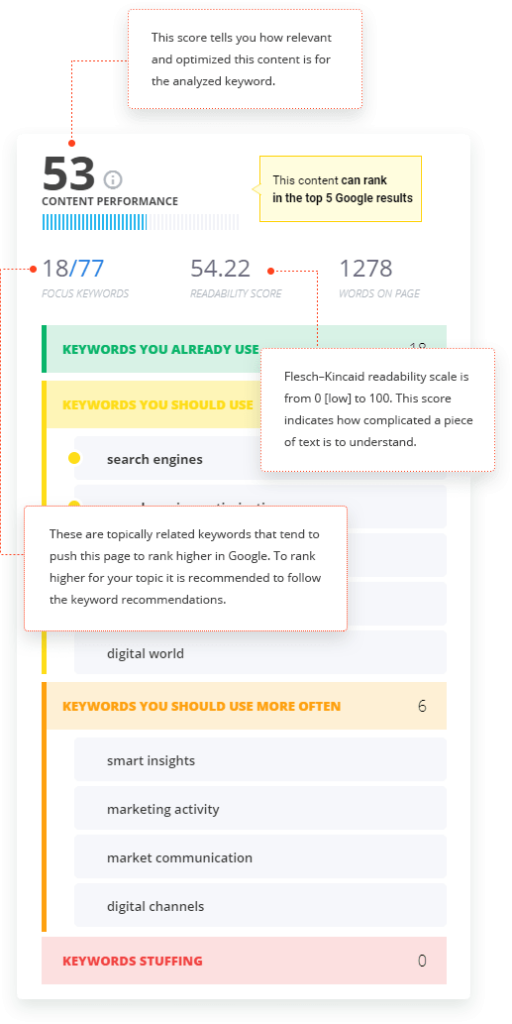


Adrian, you made me dig even deeper.
I expected only a way to advertise in Google, but there are some other options. Thank you
Nice insight! Thanks for sharing it. It might be really interesting an article about how to get in the snack pack.
Hey. You can check out the article from DOZ I mentioned in the above comment.
It summarizes how to do that. However, note that the most important factor is probably the user’s location.
The closer you are to a restaurant, the higher that restaurant will tend to rank.
Very comprehensive. Thanks for sharing. Now, how do yo handle multiple websites in different niches?